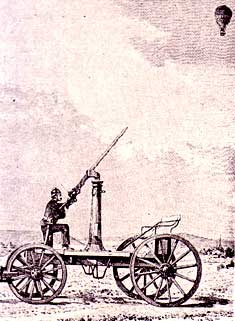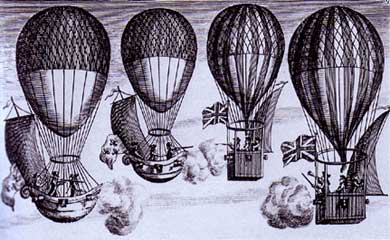



The Balloon Bridge from Paris during the siege by the Prussians- 1870-71
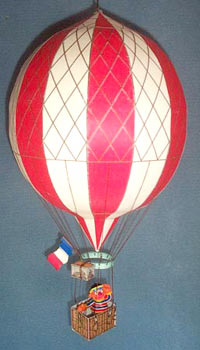
The siege of Paris in the Franco-Prussian war is usually quoted as the beginning of the practical use of balloons for military purposes. In 1870, Paris was completely cut off from the Prussians so the government used balloons to get out and over the enemy lines and .
The Paris balloon operations were basically little more than just an early air mail system. Important officials and messages were ballooned out of the capital and replies were brought back by carrier pigeons.
During the course of the fighting more than 100 passengers were ballooned across the German lines, in spite of specially designed anti-aircraft guns being used to try to shoot them down. The balloons also carried more than 21 million letters and more than 400 pigeons to carry return messages.
A few sheets from the large version of the Paris Siege Balloon model. Diameter is about 10"
My Great Grandfather was in Paris during the siege and sent a number of letters to relatives on the balloons. My cousins still have them, complete with postage marks. The letters are written on fine almost transparent tissue and are crossed. That is once the page was filled the letter was rotated 90 degrees and written on again. The page was then turned over and the process repeated. 4 pages of writing to one sheet. Very hard to read though. Regards....Eric Marchant
Yet another beauty! Excellent, dude...Z
What . . .? Pigeon on a stick. . . ? Nice job. John
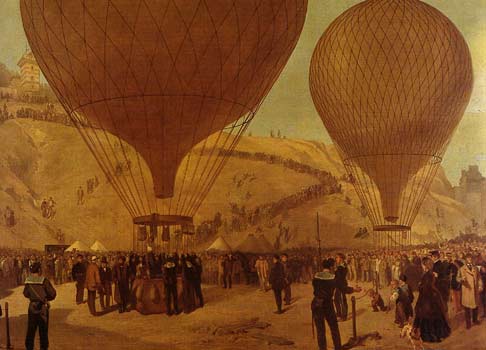 The scene at Paris' Place Saint-Pierre in September 1870 was
like a caricature of those resplendent moments when ballooning
was in its colorful infancy. The bold and confident aeronaut climbed
into his frail gondola; the balloon swayed gently on its ropes.
The scene at Paris' Place Saint-Pierre in September 1870 was
like a caricature of those resplendent moments when ballooning
was in its colorful infancy. The bold and confident aeronaut climbed
into his frail gondola; the balloon swayed gently on its ropes.
The murmur of the crowd rose to a full-throated roar as the balloonist cast off ballast and his vessel leaped from the pavement to the morning sky, arching above the placid River Seine. Aeronaut Jules Duruof peered over the side at the brilliant city diminishing before his eyes. It was just like the early days.
A Paris breeder of racing pigeons proposed that any more balloons leaving Paris should include carrier pigeons among their loads. These could then return to the city with messages from outside, opening up a two-way dialogue. The next problem, the limited supply of balloons existing in the beleaguered city, would take more planning to solve.
But Duruof's balloon was no gaily painted confection; it was an old and leaky veteran. And the mission that sent him sailing soundlessly over the countryside beyond Paris was no triumphant demonstration of a new wonder but an act of deliverance: Duruof was escaping a city under siege. The angry cannons of the Prussians sent ineffectual bursts of fire at him as he drifted across their siege lines and coolly showered visiting cards-his only means of retaliation-on their heads.
Duruof's cargo was 227 pounds of mail, the first to leave Paris since the siege had begun a few days before. He also carried the hopes of Parisians that balloons would somehow help them survive. With every means of ground communication cut off, balloons represented the only link between Paris and the outside world-including France's provisional government in Tours, 125 miles to the southwest.
The notion of using balloons as a life line for the besieged was as old as ballooning itself, but the French were about to test the idea on a scale never before imagined. Before this extraordinary effort ended, the country would build a fleet of balloons and train the men to fly them; the essential business of a nation at war would be transacted through messages carried by balloon; divided families would remain in touch, and a flock of carrier pigeons would be assembled to bring word from the outside back to the city. In the end a total of 66 balloons carrying 102 passengers and two and a half million letters left Paris in this way, and all but eight of the balloons landed safely and among friends.
On the first such flight, Jules Duruof returned peacefully
to earth on the grounds of a chateau about 50 miles west of the
capital. Government dispatches in hand, he boarded a train to
carry them personally to Tours. Other aeronauts took two more
flights in the next week, carrying a dozen pigeons for use in
bearing messages back to Paris. These flights also reduced the
city's supply of serviceable balloons to one, which was assigned
to the well-known balloonist Gaston Tissandier. He ascended on
the last day of September with three pigeons and 25,000 letters,
although his first good look at the balloon that day almost drained
away his nerve: There were "holes big enough for my little
finger to pass through," he wailed, "a whole constellation
of punctures. This is no longer a balloon, it is a skimmer."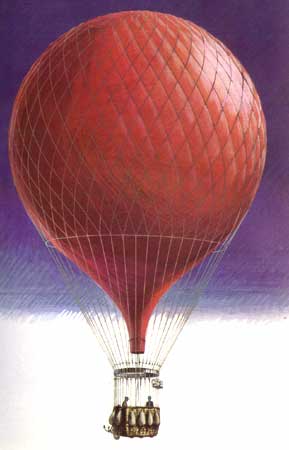
Overcoming his doubts that he could clear even the treetops, Tissandier rose above the Prussian guns to an altitude of 3,000 feet and floated toward Versailles. The novel sight of his battle-scarred homeland spread out beneath him was "sad, barren, horrible," the balloonist wrote later. "Not a soul on the roads, not a carriage, not a train," he recalled. "All the demolished bridges offer the appearance of abandoned ruins. Not a soldier, not a sentinel, nothing. You might think yourself on the outskirts of an ancient city destroyed by time."
Trouble soon jolted Tissandier out of his gloomy reverie. Forced downward by cooling temperatures that contracted the gas in his balloon, he came perilously close to a troop of Prussian cavalrymen. But Tissandier managed to fling out enough ballast-and bundles of anti Prussian propaganda-to rise again out of range. Two hours later he made a bracing but relatively painless landing when a sudden downdraft seized his balloon at an altitude of 50 feet and pushed it to earth. Like Duruof, Tissandier traveled on to Tours by rail.
In Paris, meanwhile, a force of seamstresses, workmen and land-locked sailors, who were supervised by the veteran balloonist Eugene Godard, worked tirelessly to replenish the supply of balloons that Tissandier's flight had exhausted. Two huge railroad stations had been transformed into temporary balloon factories; the British journalist Henry Vizetelly described the bizarre and bustling scene at one of them, the Gare d'Orleans:
"Under the vast iron and glass arched roof-on the long metal rafters of which sailors balanced themselves or sat astride, engaged in suspending long strips of colored calico reaching almost to the ground, scores of women were occupied, either in spreading out and ironing long pieces of material or else in soaking the calico to get rid of its stiffness.
Having been hung up to dry, the material was then cut out to the various patterns, marked out to their full size upon the ground, and after a preliminary varnishing a hundred or more work-girls, seated at long tables and superintended by Madame Godard, proceeded to sew the seams with a mechanical exactitude." Each balloon, which took about 12 days to complete, was equipped with a wicker car, a small pigeon cage and the necessary barometer-for gauging altitude compass and thermometer.
Leon Gambetta:
Thousands of Parisians flocked to the Place Saint-Pierre on October
7, 1870, to cheer the ascent of one of the first of the new balloons.
Its passenger, snug in a long greatcoat and fur hat, was the most
important traveler who would ride a siege balloon -Minister of
the Interior Leon Gambetta, whose mission was to reinvigorate
the faltering government in Tours and to organize and rally an
army.
He almost missed his chance. Dropping uncomfortably low over a Prussian-held area, his balloon escaped capture only when the pilot hastily jettisoned ballast. An enemy bullet grazed Gambetta's hand as the craft soared out of range and leveled off at an altitude so high that the earth looked to the shaken Minister like "a badly designed carpet."
The landing near Montdidier, 55 miles north of Paris, was another
near-miss: The basket snagged in the branches of a large oak tree
and overturned, nearly dumping its occupants. Local peasants rescued
Gambetta, and a pigeon was sent homing back to Paris with the
eagerly awaited news that he had landed safely and was proceeding
to Tours.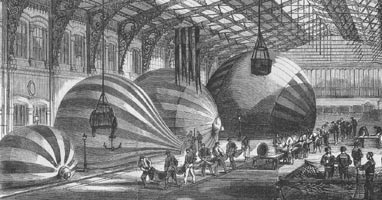
The balloon flights persisted through October and into November, as the Prussian vise on Paris gradually tightened. Prussian artillery continued to pound the city. French authorities, alarmed by reports of a new enemy anti balloon gun, which was mounted on a swivel, decreed in late November that all subsequent balloon ascensions would take place under cover of night. This change led to the most extraordinary flight of the siege. Two aeronauts, flying in darkness and uncertain of their location, went on a 15-hour, 800-mile voyage across the North Sea; when they finally landed they found themselves, to their astonishment, in the snow-carpeted wilds of central Norway.
The men were bearing a vital communique informing Gambetta and his commanders of a plan to break through the siege. By the time the weary balloonists had made their way by land to Oslo, and from there to Tours, the breakout attempt was already under way. It failed, and so in the end did Gambetta's gallant effort to organize French resistance.
The 66th and final flight of the siege took off on January 28, 1871, the same day that an armistice ending the Franco-Prussian War was signed at Versailles. A month later Prussian troops paraded through Paris. And soon after that the French showed that they had learned at least one valuable lesson from the siege: The ballooning school that Napoleon had closed more than 70 years before was reopened.
The dramatic success of the Paris airlift, combined with American aeronauts' achievements in the Civil War, had forcefully demonstrated the two great military functions that balloons were equipped to perform -battlefield reconnaissance and communication under siege.
The last prewar balloon to leave departed at the end of September, but by then production lines had been set up in two Parisian railway terminals, the Gare du Nord and the Gare d'Orleans. Because the trains no longer ran, as the routes had been cut by the Prussians, these were ideal buildings to hold ranks of seamstresses and rope-makers along the silent platforms. Each completed balloon was filled with air and hung from the high station roofs to check for leaks.
The balloons were made from cotton cloth, as cheaply as possible, as they had to make only one flight apiece. One of them carried the French politician Leon Gambetta, who was wounded in the hand by a shot from a Prussian rifleman, but nevertheless escaped to revive French spirits. In all, 66 balloons left Paris during the siege, but the chance winds sent many on long and sometimes fatal journeys. One balloon reached Norway after a flight of almost 2,000 miles; others landed in Holland and Belgium; and another one flew all the way to Munich in the heart of Germany, where its intrepid crew was arrested and imprisoned on landing.
When an armistice was signed and the siege was raised, five balloons were ready to fly. During the course of the fighting more than 100 passengers had been carried across the German lines, in spite of specially designed anti-aircraft guns being used to try to shoot them down. The balloons also carried more than 21, million letters and more than 400 pigeons to carry return messages. These were recorded on microfilm, so that the equivalent of 5,000 letters could be carried by a single bird, and they could be read and transcribed with the aid of a specially developed projector.
The next step in military lighter-than-air flight would have to wait for the invention of the airship, though civilian interest in balloons entered a new phase with the fashion for balloon racing, and the rise of the sporting balloon. |
The drawing below is a view of how balloons might be used
as war assets. The two on the left are French and the others
are British. Notice the sails as a carry-over from sailing ships. The first balloon bombing raid ever happened in June 1849
when pilotless hot-air balloons were send against Venice by the
Austrians. The bombs were released by timing devices , no lives
were lost, and little damage was done.
|
Interesting facts:
One balloon traveled to Norway. Many were fired at, but few injured.
Three balloons fell into the hands of the enemy near Paris, and
two in Germany. Two were lost at sea, each manned by a sailor.
The average distance traveled was about 180 miles, and the speed varied from seven to fifty miles an hour, and in one instance, eighty miles.
During four months, sixty-six balloons left Paris, of which fifty-four were specially made by the administration of posts and telegraphs.
One hundred-and-sixty persons were carried over the Prussian lines.
Nine tons of dispatches, or 3,000,000 letters were' successfully conveyed to their destinations. 360 pigeons were taken up, of which, however, only fifty-seven returned to Paris, these conveyed, as Lieut. Baden-Powell reminds us, 100,000 messages.
One of the strangest chapters in the history of ballooning, as well as in the annals of France, is the air-bridge that was established when Paris was besieged in the Franco-Prussian war of 1870-71 - When the German armies, in September 1870, held the French capital in their iron grip, the timing was most inopportune and very critical for the French: a new government had recently been formed in the city of Tours, in southern France, while the Ministry of Defense remained in Paris; and now the connections between them were severed.
Several balloon pilots such as Nadar, the Godard brothers, Gaston Tissandier and others were staying in the besieged city and immediately approached the postmaster-general, Germain Rampont-L6chin, with the proposition that communication with the outside world be re-established by means of balloons. A carrier pigeon fancier, van Roosebecke, proposed further that the balloons carry pigeons which could later return to Paris with messages from the provinces.
These ideas met with the ready approval of Rampont, who took immediate steps to have them realized; and the first balloon departed with mail on 23 September from Place SaintPierre in Montmartre. Jules Duruof was the pilot, and he used his old and leaky balloon Le Neptune, which three hours later landed well behind the enemy lines at Rvreaux, some 56 miles west of Paris.
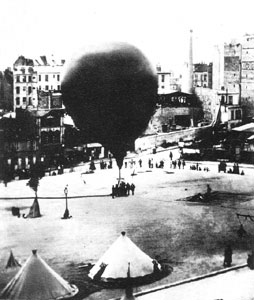 |
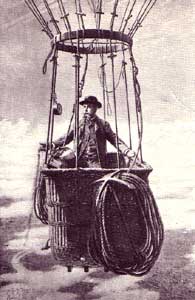 |



